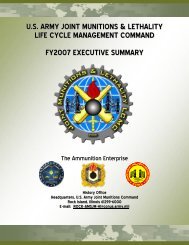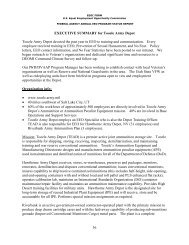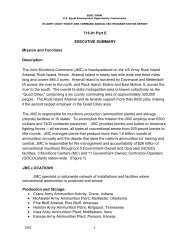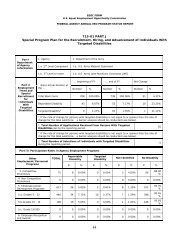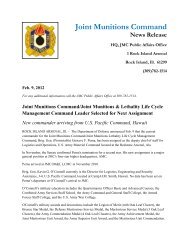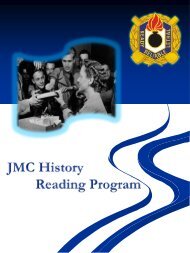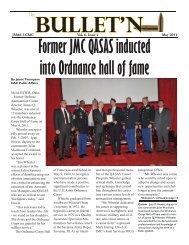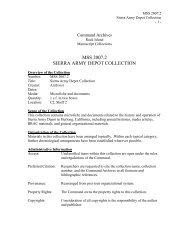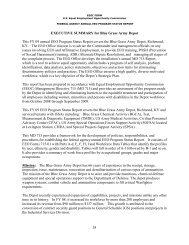History of the Ammunition Industrial Base - JMC - U.S. Army
History of the Ammunition Industrial Base - JMC - U.S. Army
History of the Ammunition Industrial Base - JMC - U.S. Army
Create successful ePaper yourself
Turn your PDF publications into a flip-book with our unique Google optimized e-Paper software.
provided is quantifiable and validated by repeatable methodologies. The MRR <strong>Ammunition</strong><br />
COP allows DA G3/5/7 override capability to make qualitative judgments outside <strong>the</strong> system.<br />
Once qualitative judgments are made, JM&L-LCMC is notified and <strong>the</strong> information is passed<br />
onto Program Managers and Commodity Teams. The MRR is <strong>the</strong>n reconstructed as <strong>the</strong> Balcony<br />
Brief by <strong>the</strong> Readiness Directorate where acquisition, technical, production and logistic solutions<br />
are applied to items that are not in a green or issueable stated. 174<br />
Finally, working with <strong>the</strong> Joint Ordnance Commanders Group (JOCG), progress was<br />
made towards creation <strong>of</strong> a joint munitions reporting capability. The Navy linked <strong>the</strong>ir Ordnance<br />
Information System (OIS) Naval Forces Readiness Operations Assessment (NFORA) system to<br />
<strong>the</strong> National Level <strong>Ammunition</strong> Capability (NLAC) system. NLAC is a joint munitions asset<br />
reporting platform. NFORA is a web-based system utilizing color-coded readiness ratings<br />
similar to <strong>the</strong> <strong>Army</strong> MRR. The Marine Corps linked <strong>the</strong>ir <strong>Ammunition</strong> Readiness System (ARS)<br />
to NLAC, and is having <strong>JMC</strong> track <strong>the</strong>ir readiness in <strong>the</strong> MRR. The ARS was designed using<br />
<strong>the</strong> <strong>Army</strong> MRR as a model and has a very similar look and feel. In addition to <strong>the</strong>se new links,<br />
NLAC has duplicated <strong>the</strong> <strong>Army</strong> MRR function without a link and that capability was being beta<br />
tested. The MRR continues to transform and merge with all Services in 2007.<br />
During OEF/OIF <strong>the</strong> system highlighted and prioritized funding for specific ammunition<br />
pacing items and o<strong>the</strong>r shortages. The ability to project ratings into <strong>the</strong> future assisted <strong>JMC</strong> in<br />
funding maintenance programs to upgrade on-hand stocks into issuable condition codes. In<br />
addition, visibility from <strong>the</strong> MRR allowed more timely decisions on shifting <strong>of</strong> stock from one<br />
<strong>the</strong>ater to ano<strong>the</strong>r.<br />
In 2009, MRR improvements changed <strong>the</strong> way <strong>JMC</strong> „stacked‟ assets against<br />
requirements. Working closely with DA, a way to better reflect real allocation priorities was<br />
established. Prior to this method change, war reserve requirements were considered first, and in<br />
total, held priority over training requirements. With <strong>the</strong> change, a critical level <strong>of</strong> war reserve<br />
requirements are considered first, <strong>the</strong>n training requirements are considered, and finally, <strong>the</strong><br />
balance <strong>of</strong> war reserve requirements are applied. Critical war reserve levels are determined by<br />
DA.<br />
How does <strong>the</strong> MRR impact <strong>the</strong> industrial base? Being able to accurately report inventory<br />
and calculate what we have on hand or in production, to provide ammunition for war, training, or<br />
emergencies; helps regulate requirements. The look at each component and end item shows<br />
where focus needs to be directed within <strong>the</strong> commercial or government base. As we have<br />
learned from previous wars, forecasting requirements and determining what needs to be<br />
produced is a challenge that has directly impacted <strong>the</strong> size <strong>of</strong> <strong>the</strong> base. Over and underestimation<br />
have caused large build ups and reductions in <strong>the</strong> base. Though situations may arise outside <strong>of</strong><br />
requirements/readiness control, it is reasonable to assume that <strong>the</strong> tool will continue to be useful<br />
at all levels <strong>of</strong> <strong>Army</strong> and Joint Services to assist in industrial base decisions.<br />
<strong>Industrial</strong> <strong>Base</strong> Assessment Tool (IBAT)<br />
In addition to assessing <strong>the</strong> readiness <strong>of</strong> <strong>the</strong> stockpile, <strong>the</strong> <strong>JMC</strong> worked with <strong>the</strong><br />
<strong>Ammunition</strong> Enterprise partners and contractor, Decision Sciences Inc. to develop <strong>the</strong> <strong>Industrial</strong><br />
174 Joint Munitions Command, “MRR and Balcony Brief” Briefing. 28 March 2006: Slide 1-4.<br />
58



